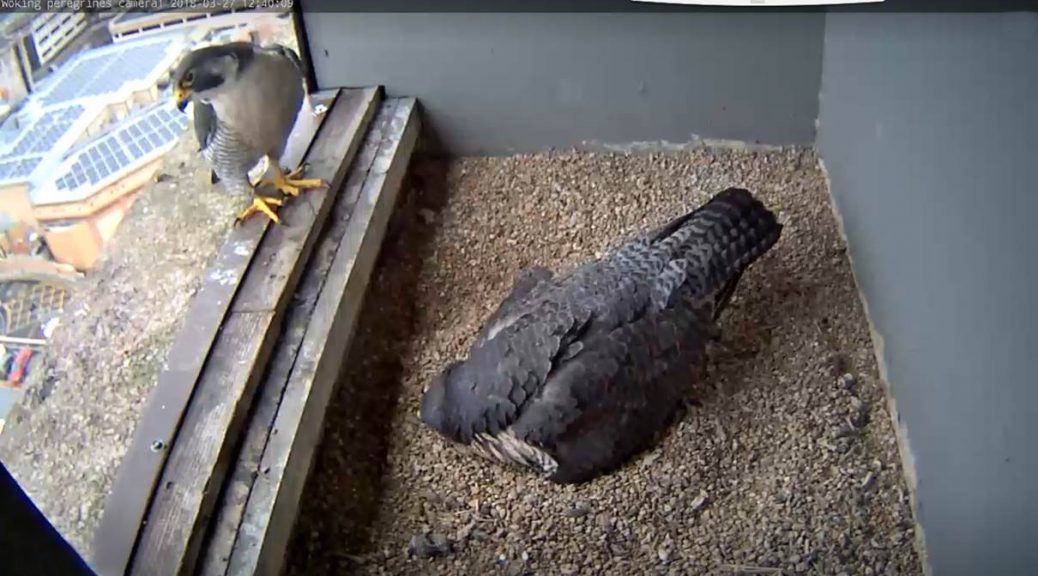THE WOKING PEREGRINE PROJECT – Nov 2016
John Bannister of Guildford Environmental Forum wowed us with an amazing conservation project close to home with people coming together from different organisations and interests to achieve success.
There were 1100 breeding pairs of Peregrine Falcons in the UK before the Second World War. Numbers dropped during World War II as many were shot as they were thought to be taking carrier pigeons. By 1965 numbers had crashed, up to 80% of the population had been lost due to agricultural chemicals like DDT as these pesticides built up in the food chain and caused increased adult mortality. Only birds in remote parts of the Scottish Highlands were unaffected. Numbers are now at 1500 plus pairs. These birds are the fasted on the planet, in a stoop they can reach up to speeds of 290 km/h. They have binocular vision that is 8 times better than ours.
Over the last fifteen years peregrines have been seen on Export House in Woking and have tried to breed there on a number of occasions but without success. In the past, eggs have been flooded or damaged as no suitable place existed on the roof of the building.
John explained that In June of 2015, he and James Sellen of the WWF, the global conservation organisationa, met with Woking Shopping Centre, to discuss whether a nest box could be installed on Export House. Eventually all involved agreed and John managed to get the relevant funding from local organisations.
The box was fitted (with a little gravel as they do not actual make a nest) on the 16th floor facing outwards in a small filter chamber plant room just under the main roof. It was installed with a camera which went live on 14th April, just in time for egg hatching ……..
The Woking Peregrines laid four red/brown eggs were laid from 22nd March to 28th March (brooding does not start until the last egg is laid). The female (known as falcon) and male (known as Tiercel) both brood the eggs. The eggs started hatching from 1st May, falcon chicks are known as Eyasses until they fledge. Some days the website (would get over 5000 hits as people wanted a rare glimpse into the life of these Peregrine chicks). Two chicks survived and with many meals of small birds (over 200 different species are known to be fed to chicks) They started to fledge 42 days after hatching on 10th June. The birds could soon be seen flying above The Peacocks car park being taught how to food pass and catch pray on the wing.
John mentioned that he was currently fundraising for 2 more cameras so the chicks can be seen when they start investigating the ledges and exercising their wings in readiness to fledge. We can now confirm that these have actually been installed in early January 2017. If you wish to follow this amazing pair we are sure they will be back so start checking the webcam in March at www.wokingperegrines.com for an amazing insight into the lives of these magnificent birds.
FUNGI WALK – September 2016
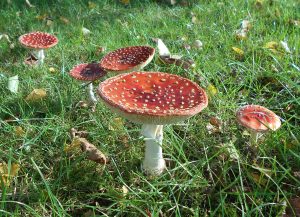
Vital to the natural order by breaking down dead or dying matter, fungi are crucial to the health of our ecosystems. The fruiting bodies grow in a vast array of colour, shape, size and locations and it was these that enticed a full group to meet on Normandy Common one September morning to learn from Dick Alder of the West Weald Fungus Recording Group.
We started, within just ten metres of the car park, with ‘The Flirt’ building our anticipation for what would be a fantastic hoard of 38 different species of fungi in just a couple of hours. The group were delighted with some spectacular displays of beauty and wonder with the ‘rooting bolete’ flesh turning blue when cut, the ‘green elf cups’ that turned the wood being grown on completely green inside, and the beautiful gelatinous ‘jelly baby’, sadly inedible. A stroll through grassland, open deciduous woodland, under conifers and in wet birch woodland provided ample diversity of fungi. There were bracket fungi on trees, a variety of mushrooms with gills, pores or teeth, as well as puff balls, cup fungi, and even fungi living on other fungi with the ‘parasitic bolete’.
Remember fungi can be seen at all times of the year, so don’t forget to look out for these unique organisms when out on your next stroll, but beware as some can be poisonous so best to leave them in place and admire them by only looking and leaving for the next lucky person to find.
DORMICE – May 2016
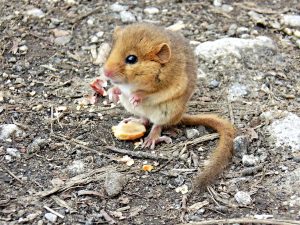
Photo by Ivo Ivov by creative commons: https://creativecommons.org/licenses/by-nc-nd/2.0/legalcode
Dave Williams of the Surrey Dormouse Group enthralled a full Therapy Gardens audience with ‘tails’ of these cute and tiny mammals for FNW’s April wildlife talk. The rarely seen Common or Hazel Dormouse – just 70mm long and 20 or so grams in weight – are arboreal mammals, relying on woodland and their connecting hedgerows. Though widespread in southern England, their populations are fragile and the species and its habitat are legally protected.
Called Hazel Dormice for their colour rather than their coincidental fondness for hazel woods and nuts, they can be distinguished from other mice by their fur-coated tail. They are agile and well adapted for climbing and prefer woodlands with an understorey of touching branches; usually nocturnal, at night they climb up into the branches to find a variety of foods including berries, ash keys, crab apples and insects. Hazelnuts are often eaten to fatten up for hibernation. Dormice leave distinctive teeth marks on nuts – they eat around the hole they make, rather than across it.
With natural nest holes disappearing due to man’s tidying of the countryside, Dormice readily use erected artificial nest boxes which also lend themselves to population monitoring (a licence is needed to check boxes and handle the animals). They hibernate for up to 7 months – sleeping on the ground in a tight ball of grass as the temperature stays more constant at ground level – and can live for up to 7 years.
Dormice have disappeared from half their historical UK range and numbers have dropped by 75% in the last 25 years. Suitable woodlands have become isolated due to hedgerow loss and fewer due to less favourable management, and the Dormouse’s sparse distribution of only 8 to 10 animals per hectare means local extinctions can happen quite easily. Man-made threats are faced on top of predation by squirrels, owls, weasels and cats. Surrey has a small but thriving population and they may live in the village’s woodlands and hedgerows, so please do tell us if you find one or suspect a furry tailed creature has been eating the hazelnuts!
BARN OWLS – March 2016
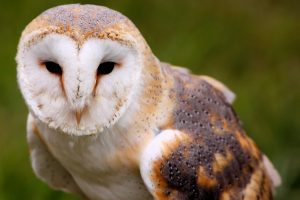
Photo by Airwolfhound by creative commons: https://creativecommons.org/licenses/by-nc-nd/2.0/legalcode
March’s wildlife talk was an opportunity for our largest ever turnout to luxuriate in Ken Anckorn’s detailed knowledge of the Barn Owl. Conservation Manager (Planning) at Surrey Wildlife Trust and Conservation Officer for Surrey Bird Club, Ken talked us through the bird’s biology and life habits. In a separate family to the true owls, there are 3-4000 pairs of Barn Owls in the UK and 30-40 pairs in Surrey but with much fluctuation. They are birds of open country but not suited to the uplands or cold, wet weather.
Barn Owls are built for one job only – hunting small mammals, which make up 95% of their diet. The quietest flier in the country thanks to the fine down on their feathers, they make no sound to warn of their approach. Their light body and large wings mean the owls can fly slowly as they quarter uncut grassland for prey, with 95% of hunting done by sound. They nest naturally in deep holes in trees or caves but have adapted well to live alongside man in barns and church towers.
Though not threatened in Europe, the Barn Owl has declined in Britain and their nests and young are now protected from disturbance by law. Their unkempt grassland feeding habitat has been reduced through agricultural intensification and they need to be lucky with food and weather to thrive. The high degree of specialism for feeding on small mammals gives the owls no fallback when prey populations are low and the specialist feathers reduce their water-proofing, meaning they can’t hunt in wet weather. Young birds are prone to colliding with cars and drowning in cattle troughs, and 50% of juveniles die in their first autumn and winter. Adults though often live for 5 or 6 years and can even reach 12 or 13 years.
Bearing this in mind, the next time you see a Barn Owl cross a road or field or hear their haunting screech at night – evocative of a countryside we are losing – treasure the experience and please report the sighting to a conservation body. Let’s hope those who look after our countryside can do so in a way to support these magnificent birds.
A SEASONING OF BUTTERFLIES – February 2016
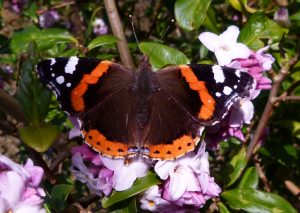
When is a brown really a blue? Or a white a brown? When it’s a butterfly! February’s wildlife talk saw a full house treated to Francis Kelly’s wonderful knowledge of the forty-one species to be found wild in the county in his “A Seasoning of Surrey Butterflies”. Francis – closely involved in the local branch of Butterfly Conservation as Publicity Officer and editor of the excellent Surrey Skipper magazine – led us through the recording year in order of appearance. Even in January, Red Admirals wake on sunny days and volunteers start searching for Brown Hairstreak eggs on blackthorn scrub.
Leading us from the hibernators through the spring, summer and migrant arrivals, Francis showed beautiful and detailed photographs that not only served to improve our understanding of these incredible insects and their complex life cycles but showed just how important our local countryside is for both common and rarer species. The North Downs are indisputably the best Surrey area for butterflies and Chiddingfold Woods is the UK stronghold for the Wood White. Pewley Down, Newlands Corner and Brookwood Cemetery are all fantastic areas that are relatively close. However, four species have become extinct in Surrey since 1992 which shows we cannot take our wildlife, and how we treat their habitats, for granted.
Inspired by Francis, many of us will be taking much more notice of the butterflies we see in our gardens and around the parish – please do send news of any interesting sightings to us.
SURREY SAFARI – January 2016
A “Surrey Safari” evening with local naturalist Geoff Lunn. Modestly describing himself as an amateur photographer, Geoff took us on a light-hearted natural history tour of The Sands village and other local wild places, showcasing the wildlife he has seen with wonderful photographs and regaling us with entertaining facts and tales of his finds and his efforts to photograph them.
He and wife Lynn have worked hard to attract wildlife to their garden through feeding, planting cover and a fantastic pond, with amphibians, dragonflies and more than fifty species of birds amongst those to share this lovely space and be captured on camera by Geoff. From the local countryside, his dedication and fieldcraft were demonstrated through beautiful photos of badgers near their sett, a nightjar at rest, a roosting long-eared owl and a sparrowhawk at the nest – the latter from forty feet up on a precarious treetop platform.
Perhaps the highlight was the story of Binton, a green woodpecker chick ejected from its nest that was found and cared for by Geoff and his family. Sharing his home, office, shoulder and shirt pocket for three months, Binton thrived and was released into the nearby woods that autumn – to return and raise a family there himself the next year. Geoff impressed, amused and inspired, beautifully illustrating just what varied wildlife can be seen on our doorstep.

